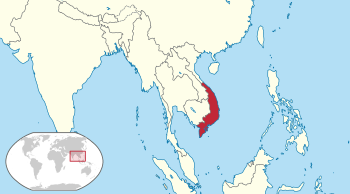South Vietnam facts for kids
Quick facts for kids
Republic of Vietnam
Việt Nam Cộng Hòa (Vietnamese)
|
|||||||||
|---|---|---|---|---|---|---|---|---|---|
| 1955–1975 | |||||||||
|
Motto: "Tổ Quốc – Danh Dự – Trách Nhiệm"
(English: "Fatherland – Honor – Duty") |
|||||||||
|
Anthem: Tiếng Gọi Công Dân
(English: "Call to the Citizens") |
|||||||||

Administrative territory of South Vietnam in Southeast Asia according to 1954 Geneva Accord
|
|||||||||
| Capital and largest city
|
Saigon | ||||||||
| Official languages | Vietnamese | ||||||||
| Recognised national languages | French | ||||||||
| Religion |
|
||||||||
| Demonym(s) | South Vietnamese | ||||||||
| Government |
|
||||||||
| President | |||||||||
|
• 1955–1963
|
Ngô Đình Diệm | ||||||||
|
• 1967–1975
|
Nguyễn Văn Thiệu | ||||||||
|
• 1975
|
Trần Văn Hương | ||||||||
| Prime Minister | |||||||||
|
• 1963–1964 (first)
|
Nguyễn Ngọc Thơ | ||||||||
|
• 1975 (last)
|
Vũ Văn Mẫu | ||||||||
| Historical era | |||||||||
|
• Referendum
|
26 October 1955 | ||||||||
|
• 1963 coup
|
2 November 1963 | ||||||||
|
• Paris Peace Accords
|
27 January 1973 | ||||||||
|
• Fall of Saigon
|
30 April 1975 | ||||||||
| Area | |||||||||
|
• Total
|
173,809 km2 (67,108 sq mi) | ||||||||
| Population | |||||||||
|
• 1955
|
12,000,000 | ||||||||
|
• 1974
|
19,582,000 | ||||||||
| Currency | đồnga | ||||||||
| Time zone | UTC+8 (Saigon Standard Time (SST)) | ||||||||
| Driving side | right | ||||||||
|
|||||||||
| Today part of | Vietnam | ||||||||
South Vietnam, officially the Republic of Vietnam (RVN, Vietnamese: Việt Nam Cộng Hòa; French: République du Viêt Nam, lit. Vietnam[ese] Republic), was a country that existed from 1955 to 1975, the period when the southern portion of Vietnam was a member of the Western Bloc during part of the Cold War. It received international recognition in 1949 as the "State of Vietnam" (a self-governing entity in the French Empire), which was a constitutional monarchy (1949–1955). The country was renamed the "Republic of Vietnam" in 1955. Its capital was Saigon (now Ho Chi Minh City). South Vietnam was bordered by North Vietnam to the north, Laos to the northwest, Cambodia to the southwest, Thailand across the Gulf of Thailand to the southwest, and the Philippines, Malaysia, Brunei, and Indonesia across the South China Sea to the east and southeast.
The Republic of Vietnam was proclaimed on 26 October 1955, with Ngô Đình Diệm as its first president, after having briefly served as premier under Emperor Bảo Đại who was exiled. Its sovereignty was recognized by the United States and 87 other nations. It had membership in several special committees of the United Nations, but its application for full membership was rejected in 1957 because of a Soviet veto (neither South nor North Vietnam were members of the UN during the Vietnam War, but the united Vietnam became a member state in 1977). South Vietnam's origins can be traced to the French colony of Cochinchina, which consisted of the southern third of Vietnam which was Cochinchina [Nam Kỳ], a subdivision of French Indochina, and the southern half of Central Vietnam or Annam [Trung Kỳ] which was a French protectorate. After the Second World War, the anti-Japanese Việt Minh guerrilla forces, led by Ho Chi Minh, proclaimed the establishment of a Democratic Republic of Vietnam in Hanoi in September 1945, issuing a Declaration of Independence modeled on the US one from 1776.
In 1949, anti-communist Vietnamese politicians formed a rival government in Saigon led by former emperor Bảo Đại. Bảo Đại was deposed by Prime Minister Ngô Đình Diệm in 1955, who proclaimed himself president after a referendum. Diệm was killed in a military coup led by general Dương Văn Minh in 1963, and a series of short-lived military governments followed. General Nguyễn Văn Thiệu then led the country after a US-encouraged civilian presidential election from 1967 until 1975. The beginnings of the Vietnam War occurred in 1955 with an uprising by the newly organized National Liberation Front for South Vietnam (Việt Cộng), armed and supported by the North Vietnam, with backing mainly from China and the Soviet Union. Larger escalation of the insurgency occurred in 1965 with American intervention and the introduction of regular forces of Marines, followed by Army units to supplement the cadre of military advisors guiding the Southern armed forces. A regular bombing campaign over North Vietnam was conducted by offshore US Navy airplanes, warships, and aircraft carriers joined by Air Force squadrons through 1966 and 1967. Fighting peaked up to that point during the Tet Offensive of February 1968, when there were over a million South Vietnamese soldiers and 500,000 US soldiers in South Vietnam. Later on the war the initial guerrilla war turned into a more conventional fight as the balance of power became equalized. An even larger, armored invasion from the North commenced during the Easter Offensive following US ground-forces withdrawal, and had nearly overran some major northern cities until beaten back.
Despite a truce agreement under the Paris Peace Accords, concluded in January 1973, after a torturous five years of on and off negotiations, fighting continued almost immediately afterwards. The regular North Vietnamese army and Việt Cộng auxiliaries launched a major second combined-arms conventional invasion in 1975. Communist forces overran Saigon on 30 April 1975, marking the end of the Republic of Vietnam. On July 2, 1976, the Provisional Revolutionary Government of the Republic of South Vietnam (which had taken over administration of the country) and the Democratic Republic of Vietnam merged to form the Socialist Republic of Vietnam.
Images for kids
-
US President Dwight D. Eisenhower and Secretary of State John Foster Dulles greet President Ngô Đình Diệm of South Vietnam in Washington, 8 May 1957.
See also
 In Spanish: Vietnam del Sur para niños
In Spanish: Vietnam del Sur para niños








